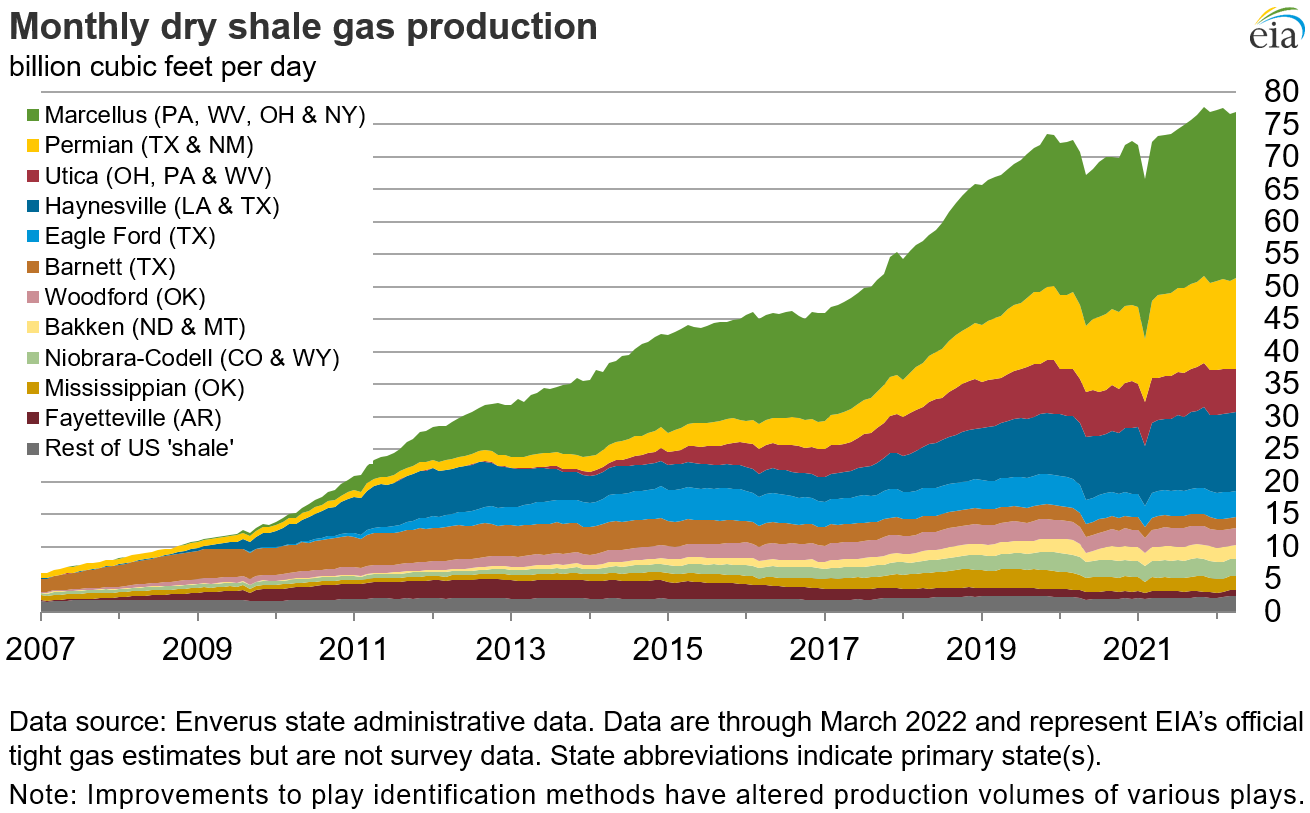In the News:
EIA expects that natural gas production in the Permian Basin will increase in 2022 and 2023
Marketed natural gas production in the Permian Basin in western Texas and New Mexico reached a new annual high of 16.7 billion cubic feet per day (Bcf/d) in 2021. In our May 2022 Short-Term Energy Outlook (STEO), we forecast that production in the Permian Basin will increase by 2.1 Bcf/d in 2022 and by an additional 1.7 Bcf/d in 2023.
The Permian Basin is the second-largest shale gas-producing region in the United States after the Appalachian Basin in Pennsylvania, West Virginia, and Ohio, which produced on average 34.8 Bcf/d of marketed natural gas in 2021. Annual marketed natural gas production in the Permian has been rising steadily since 2012. Even during the COVID-19 pandemic, marketed natural gas production rose by 13% to average 15.4 Bcf/d in 2020.
Most of the natural gas production in the Permian is associated gas produced from oil wells. As a result, producers operating in the basin respond to fluctuations in the crude oil price when they plan their exploration and production activities, including whether to deploy drilling rigs or take rigs out of operation.
After falling from the end of 2014 through mid-2016, the number of drilling rigs operating in the Permian Basin remained relatively high from mid-2017 to the end of 2019, averaging 492 in November 2018, amid relatively elevated crude oil prices. Crude oil prices and rigs both declined in 2020. In 2021, WTI crude oil prices increased steadily, averaging $68 per barrel (b) for the year compared with $39/b in 2020, and the number of rigs operating in the basin rose as well. In our May 2022 STEO forecast, we expect WTI to average $98/b in 2022 and $93/b 2023, which is expected to lead to increased oil-directed drilling activity and continued growth in associated gas production. We expect much of the growth in natural gas production over the next two years to be in the Permian Basin.
Production of natural gas in the Permian Basin, and its delivery to market, is facilitated by improved pipeline takeaway capacity. The ability to move natural gas out of the Permian Basin production region to consuming regions increased in 2021 with three new projects: Kinder Morgan Energy Partners’ Permian Highway Pipeline (January), WhiteWater’s Whistler Pipeline (July), and Summit Midstream Partners’ Double E Pipeline (November). The additional capacity allows producers to reach demand centers in Mexico and along the Texas Gulf Coast, including liquefied natural gas export terminals. These projects added 5.5 Bcf/d of takeaway capacity in the Permian, which is currently estimated to total 17.5 Bcf/d, according to PointLogic.
The operators of all three pipelines that were put into service in 2021 recently announced expansion projects that would increase takeaway capacity out of the Permian production region by 1.8 Bcf/d. Two additional projects have also recently been announced: Kinder Morgan’s expansion of the Gulf Coast Express Pipeline, which would add an additional 0.6 Bcf/d of takeaway capacity by the end of 2023, and EnLink Midstream’s Matterhorn Express Pipeline, which would add another 2.5 Bcf/d of takeaway capacity out of the Permian Basin by the fourth quarter of 2024.
Overview:
(For the week ending Wednesday, May 25, 2022)
- Spot prices: Natural gas spot prices rose at most locations this report week (Wednesday, May 18, to Wednesday, May 25). The Henry Hub spot price rose from $8.45 per million British thermal units (MMBtu) last Wednesday to $9.30/MMBtu yesterday.
- International spot prices: International natural gas spot prices declined this report week. Bloomberg Finance, L.P., reports that the swap prices for liquefied natural gas (LNG) cargoes in East Asia fell $1.64/MMBtu to a weekly average of $21.88/MMBtu. At the Title Transfer Facility (TTF) in the Netherlands, the most liquid natural gas spot market in Europe, the day-ahead price fell $2.20/MMBtu to a weekly average of $25.92/MMBtu. In the same week last year (week ending May 26, 2021), the prices in East Asia and at TTF were $10.05/MMBtu and $9.04/MMBtu, respectively. Replenishment of working natural gas in European storage fields is contributing to the shrinking premium for European versus East Asian natural gas.
- Futures: The price of the June 2022 NYMEX contract increased 60.3 cents, from $8.368/MMBtu last Wednesday to $8.971/MMBtu yesterday. The price of the 12-month strip averaging June 2022 through May 2023 futures contracts increased 44.2 cents to $8.169/MMBtu.
- Storage: The net injections into working gas for the Lower 48 states totaled 80 billion cubic feet (Bcf) for the week ending May 20. Working natural gas stocks totaled 1,812 Bcf, which is 18% lower than the year-ago level and 15% lower than the five-year (2017–2021) average for this week.
- NGPLs: The natural gas plant liquids composite price at Mont Belvieu, Texas, fell by 2 cents/MMBtu, averaging $12.48/MMBtu for the week ending May 25. Weekly average ethane prices rose 4%, following the 6% increase in natural gas prices at the Houston Ship Channel. The ethane premium to natural gas narrowed by 6%. The price of ethylene rose 1%, resulting in a narrower ethylene to ethane spread, which fell 8%. The Brent crude oil price rose 2%, while prices of heavier natural gas liquids fell, except for isobutane, which also rose 2%. Normal butane and propane prices both fell 2%, and natural gasoline prices fell by 4%. The propane discount to crude oil widened by 10%.
- Rigs: According to Baker Hughes, for the week ending Tuesday, May 17, the natural gas rig count increased by 1 rig from a week ago to 150 rigs. One rig was added in the Haynesville, and the rig count in all other regions remained flat week over week. The number of oil-directed rigs increased by 13 rigs to 576 rigs. The Permian added eight rigs, the Eagle Ford added three rigs, one rig each was added in the Haynesville, the Ardmore Woodford, and in an unspecified producing region, and one rig was dropped in the Granite Wash. The total rig count now stands at 728 rigs, 273 more rigs than the same week last year, and the highest level since March 27, 2020, when the number of rigs was also 728.
Prices/Supply/Demand:
Prices along the Gulf Coast rise as demand growth in the Southeast and Texas outpaces growth in supply. This report week (Wednesday, May 18, to Wednesday, May 25), the Henry Hub spot price rose 85 cents from $8.45/MMBtu last Wednesday to $9.30/MMBtu yesterday. Prices across the South were higher, even as temperatures in the region moderated toward normal, following several weeks of above-normal temperatures. Declines in natural gas consumption by the electric power sector along the Gulf Coast, which fell by 0.6 billion cubic feet per day (Bcf/d) (12%) this report week, were more than offset by growth in feed gas deliveries to LNG export terminals in the region, which grew by more than 0.9 Bcf/d (9%) to 11.7 Bcf/d, according to data from PointLogic. Temperatures in the Houston Area averaged 79°F this report week, on par with normal for this time of year, after averaging 3°F above normal last week, resulting in cooling degree days (CDDs) falling from 118 CDDs last week to 102 CDDs this report week. Feed gas deliveries to LNG export terminals in Texas increased by 0.4 Bcf/d, and deliveries to terminals in Louisiana increased by 0.6 Bcf/d.
Prices in the Midwest increase with the national average as temperatures fluctuate. At the Chicago Citygate, the spot price increased 77 cents from $8.16/MMBtu last Wednesday to $8.93/MMBtu yesterday. Higher spot natural gas prices at the Henry Hub kept Midwest prices high even as regional consumption in key sectors declined.
Prices across the West rise as the natural gas share of electricity generation increases in California. The price at PG&E Citygate in Northern California rose rose 67 cents, up from $9.70/MMBtu last Wednesday to $10.37/MMBtu yesterday, reflecting rising prices at major origin points for natural gas into the PG&E service territory. The price at Malin, Oregon, the northern delivery point into PG&E service territory, rose $1.07/MMBtu this report week, from $9.70/MMBtu last Wednesday to $10.37/MMBtu yesterday. The price at Opal in southwest Wyoming, the origin point of the Ruby Pipeline that delivers natural gas into the Malin hub, rose 90 cents from $8.15/MMBtu last Wednesday to $9.05/MMBtu yesterday. The price at Sumas on the British Columbia/Washington State border, the main pricing point for natural gas into the Pacific Northwest, rose 87 cents, from $7.95 last Wednesday to $8.82/MMBtu yesterday. Temperatures across much of the West, particularly across the Rocky Mountains, remain below normal this report week. Temperatures in the Seattle City Area averaged 56°F this report week, 2°F lower than normal. Natural gas consumption in all sectors of the Pacific Northwest decreased by 0.2 Bcf/d (13%), according to data from PointLogic.
The price at SoCal Citygate in Southern California increased $1.40 from $8.71/MMBtu last Wednesday to $10.11/MMBtu yesterday. Temperatures in the Riverside Area, inland from Los Angeles, averaged 68°F this report week, 4°F lower than last report week and 1°F lower than normal. Natural gas consumption in the residential and commercial sectors in California decreased by 0.1 Bcf/d (7%), while consumption in the electric power sector increased by 0.2 Bcf/d (13%), according to data from PointLogic. The natural gas share of electricity generation in California increased sharply on May 24 to 42.7% from 31.2% the day before, reaching the highest share since April 26.
Prices in the Northeast increase as consumption of natural gas across all sectors increases. At the Algonquin Citygate, which serves Boston-area consumers, the spot price of natural gas rose $1.04 from $7.99/MMBtu last Wednesday to $9.03/MMBtu yesterday. At the Transcontinental Pipeline Zone 6 trading point for New York City, the spot price increased 45 cents from $7.78/MMBtu last Wednesday to $8.23/MMBtu yesterday. Consumption of natural gas in both New England and the New York and New Jersey area was up across all sectors this week according to data from PointLogic, as temperatures ranged from several degrees above normal to several degrees below normal through the week. Both regions experienced above-normal temperatures over the weekend, resulting in increased natural gas consumption in the electric power sector. Over the weekend, temperatures in the New York Central Park Area averaged 78°F (14°F above normal), resulting in 27 CDDs. In the Boston Area, the average temperature on Sunday was 73°F (13°F above normal) resulting in 8 CDDs. Consumption of natural gas in the residential and commercial sectors also increased this week for both regions because temperatures on other days of the week were below normal, resulting in 14 heating degree days (HDDs) in the New York Central Park Area and 28 HDDs in the Boston Area, above last week’s 1 HDD and 10 HDDs, respectively.
Appalachian prices rise, but by less than prices in most other markets. Spot prices also increased in the Appalachian region following other prices across the United States, but not as much as at the Henry Hub, even though consumption of natural gas decreased in the region. Total consumption of natural gas in Appalachia decreased 0.2 Bcf/d (3%), led by a decrease in consumption by the electric power sector. The Tennessee Zone 4 Marcellus spot price increased 38 cents from $7.47/MMBtu last Wednesday to $7.85/MMBtu yesterday. The price at Eastern Gas South in southwest Pennsylvania rose 54 cents from $7.57/MMBtu last Wednesday to $8.11/MMBtu yesterday.
West Texas prices increase, but by less than prices along the Gulf Coast. The price at the Waha Hub in West Texas, which is located near Permian Basin production activities, rose 76 cents this report week, from $7.97/MMBtu last Wednesday to $8.73/MMBtu yesterday. The Waha Hub traded 57 cents below the Henry Hub price yesterday, compared with last Wednesday when it traded 48 cents below the Henry Hub price. Production and disposition (in-region demand plus flows to other regions) of natural gas in the Permian Basin region both decreased this week by approximately 0.4 Bcf/d (2%), according to data from PointLogic.
U.S. natural gas supply decreases slightly week over week. Overall U.S. natural gas supplies fell by 0.2% (0.2 Bcf/d) compared with the prior report week, according to data from PointLogic. Dry natural gas production decreased by 0.1% (0.1 Bcf/d), and average net imports from Canada decreased by 1.9% (0.1 Bcf/d) from the prior report week.
U.S. natural gas demand rises slightly with mixed temperatures. Total U.S. consumption of natural gas rose by 1.7% (1.0 Bcf/d) compared with the previous report week, according to data from PointLogic. Temperatures across much of the West were below normal this report week, while temperatures across the South, Mid-Continent, and Northeast averaged mostly above normal, but they have moderated compared with prior weeks. The residential and commercial sectors accounted for the largest increase in consumption week over week, rising by 16.3% (1.6 Bcf/d). Natural gas deliveries to U.S. liquefied natural gas (LNG) export facilities (LNG pipeline receipts) also rose, averaging 12.9 Bcf/d, or 0.9 Bcf/d higher than last week. Industrial sector consumption increased by 1.4% (0.3 Bcf/d) week over week. Natural gas consumed for power generation partly offset these gains, declining by 2.8% (0.9 Bcf/d) week over week. Natural gas exports to Mexico were unchanged at 5.6 Bcf/d.
U.S. LNG exports increase by five vessels this week from last week. Twenty-four LNG vessels (eight from Sabine Pass, five from Freeport, four from Corpus Christi, three from Cameron, and two each from Calcasieu Pass and Cove Point) with a combined LNG-carrying capacity of 90 Bcf departed the United States between May 19 and May 25, according to shipping data provided by Bloomberg Finance, L.P. Higher exports this week can be attributed, in part, to the completion of seasonal maintenance at LNG terminals.
Storage:
The net injections into storage totaled 80 Bcf for the week ending May 20, compared with the five-year (2017–2021) average net injections of 97 Bcf and last year's net injections of 109 Bcf during the same week. Working natural gas stocks totaled 1,812 Bcf, which is 327 Bcf lower than the five-year average and 387 Bcf lower than last year at this time.
According to The Desk survey of natural gas analysts, estimates of the weekly net change to working natural gas stocks ranged from net injections of 76 Bcf to 103 Bcf, with a median estimate of 86 Bcf.
More storage data and analysis can be found on the Natural Gas Storage Dashboard and the Weekly Natural Gas Storage Report.
See also:
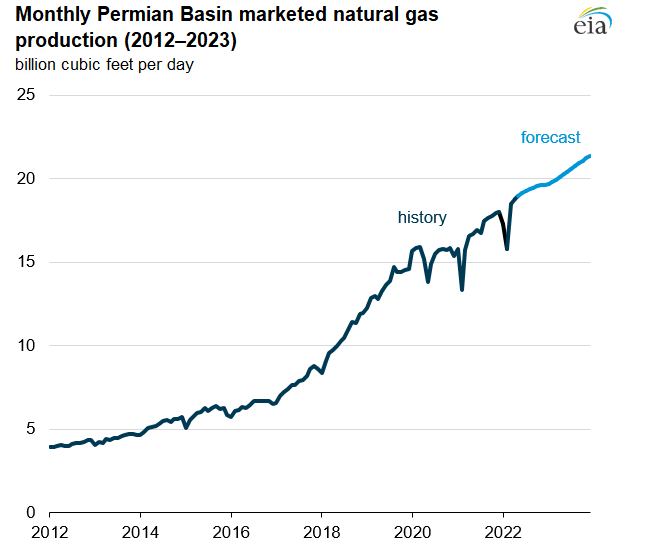
Data source: U.S. Energy Information Administration, Short-Term Energy Outlook
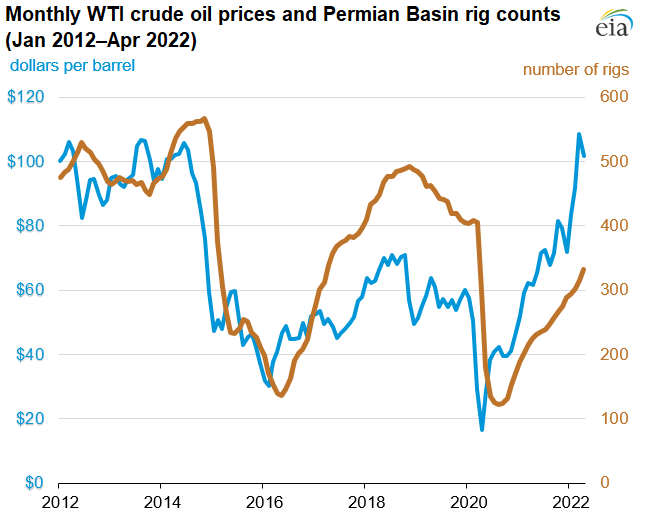
Data source: Thomson Reuters and Baker Hughes Company
Note: WTI prices are monthly averages. Rig counts are total monthly averages based on weekly estimates.

| Spot Prices ($/MMBtu) | Thu, 19-May |
Fri, 20-May |
Mon, 23-May |
Tue, 24-May |
Wed, 25-May |
|---|---|---|---|---|---|
| Henry Hub |
8.17 |
7.98 |
8.15 |
8.77 |
9.30 |
| New York |
7.83 |
7.78 |
7.33 |
7.72 |
8.23 |
| Chicago |
8.02 |
7.86 |
8.09 |
8.52 |
8.93 |
| Cal. Comp. Avg.* |
8.50 |
8.28 |
8.70 |
9.27 |
9.70 |
| Futures ($/MMBtu) | |||||
| June contract | 8.308 |
8.083 |
8.744 |
8.796 |
8.971 |
| July contract |
8.400 |
8.178 |
8.827 |
8.836 |
8.993 |
|
Data source: Natural Gas Intelligence and CME Group as compiled by Bloomberg, L.P. |
|||||
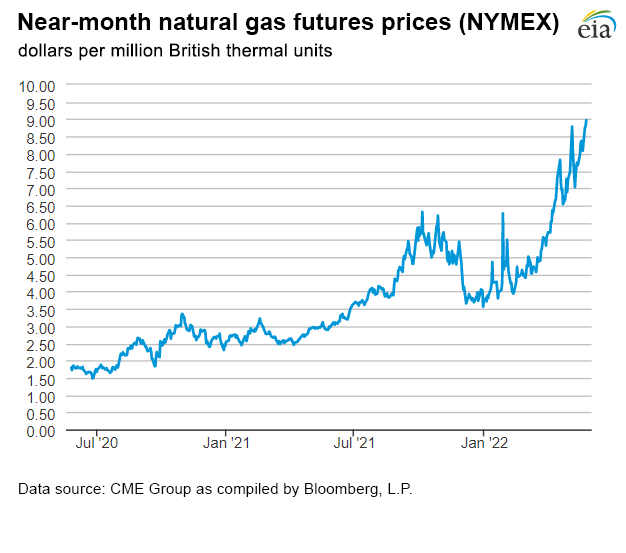
| U.S. natural gas supply - Gas Week: (5/19/22 - 5/25/22) | |||
|---|---|---|---|
Average daily values (billion cubic feet) |
|||
this week |
last week |
last year |
|
| Marketed production | 107.1 |
107.3 |
104.3 |
| Dry production | 95.0 |
95.1 |
92.4 |
| Net Canada imports | 4.9 |
5.0 |
4.3 |
| LNG pipeline deliveries | 0.1 |
0.1 |
0.1 |
| Total supply | 100.0 |
100.2 |
96.8 |
|
Data source: PointLogic | |||
| U.S. natural gas consumption - Gas Week: (5/19/22 - 5/25/22) | |||
|---|---|---|---|
Average daily values (billion cubic feet) |
|||
this week |
last week |
last year |
|
| U.S. consumption | 63.8 |
62.7 |
57.9 |
| Power | 30.5 |
31.4 |
27.9 |
| Industrial | 21.8 |
21.5 |
20.4 |
| Residential/commercial | 11.5 |
9.9 |
9.5 |
| Mexico exports | 5.6 |
5.6 |
6.3 |
| Pipeline fuel use/losses | 6.3 |
6.3 |
6.0 |
| LNG pipeline receipts | 12.9 |
12.0 |
10.7 |
| Total demand | 88.6 |
86.6 |
80.9 |
|
Data source: PointLogic | |||
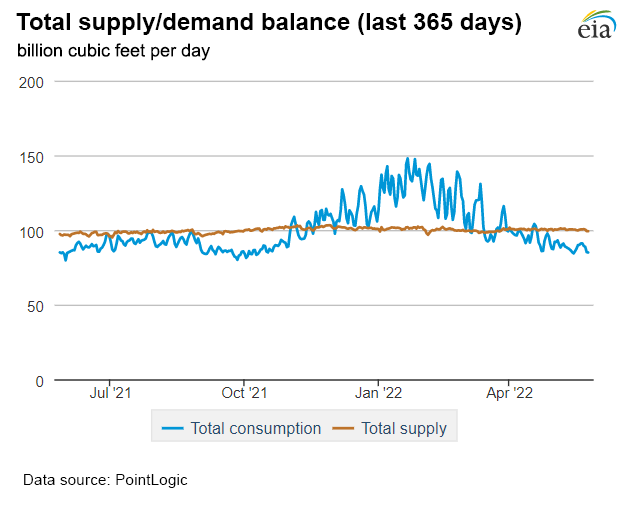
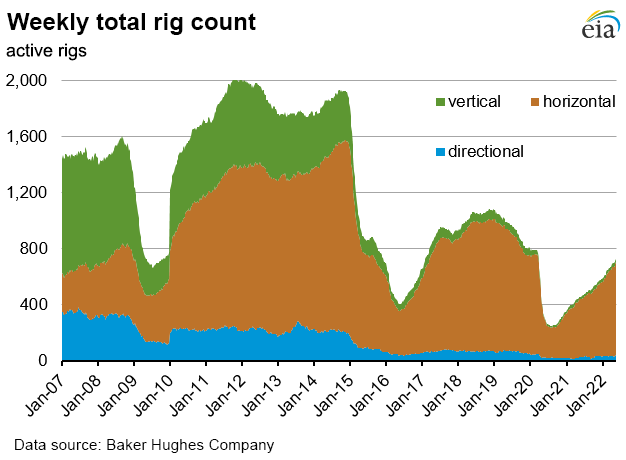
| Rigs | |||
|---|---|---|---|
Tue, May 17, 2022 |
Change from |
||
last week |
last year |
||
| Oil rigs | 576 |
2.3% |
61.8% |
| Natural gas rigs | 150 |
0.7% |
51.5% |
| Note: Excludes any miscellaneous rigs | |||
| Rig numbers by type | |||
|---|---|---|---|
Tue, May 17, 2022 |
Change from |
||
last week |
last year |
||
| Vertical | 25 |
0.0% |
66.7% |
| Horizontal | 664 |
2.0% |
61.2% |
| Directional | 39 |
2.6% |
39.3% |
| Data source: Baker Hughes Company | |||
| Working gas in underground storage | ||||
|---|---|---|---|---|
Stocks billion cubic feet (Bcf) |
||||
| Region | 2022-05-20 |
2022-05-13 |
change |
|
| East | 325 |
296 |
29 |
|
| Midwest | 391 |
364 |
27 |
|
| Mountain | 109 |
103 |
6 |
|
| Pacific | 190 |
187 |
3 |
|
| South Central | 797 |
781 |
16 |
|
| Total | 1,812 |
1,732 |
80 |
|
|
Data source: U.S. Energy Information Administration Form EIA-912, Weekly Underground Natural Gas Storage Report | ||||
| Working gas in underground storage | |||||
|---|---|---|---|---|---|
Historical comparisons |
|||||
Year ago (5/20/21) |
5-year average (2017-2021) |
||||
| Region | Stocks (Bcf) |
% change |
Stocks (Bcf) |
% change |
|
| East | 381 |
-14.7 |
388 |
-16.2 |
|
| Midwest | 495 |
-21.0 |
467 |
-16.3 |
|
| Mountain | 143 |
-23.8 |
128 |
-14.8 |
|
| Pacific | 255 |
-25.5 |
235 |
-19.1 |
|
| South Central | 925 |
-13.8 |
921 |
-13.5 |
|
| Total | 2,199 |
-17.6 |
2,139 |
-15.3 |
|
| Data source: U.S. Energy Information Administration Form EIA-912, Weekly Underground Natural Gas Storage Report | |||||
| Temperature – heating & cooling degree days (week ending May 19) | ||||||||
|---|---|---|---|---|---|---|---|---|
HDDs |
CDDs |
|||||||
| Region | Current total |
Deviation from normal |
Deviation from last year |
Current total |
Deviation from normal |
Deviation from last year |
||
| New England | 23 |
-36 |
-11 |
13 |
12 |
12 |
||
| Middle Atlantic | 18 |
-29 |
-16 |
7 |
2 |
3 |
||
| E N Central | 21 |
-32 |
-27 |
21 |
10 |
18 |
||
| W N Central | 20 |
-26 |
-20 |
28 |
14 |
21 |
||
| South Atlantic | 2 |
-16 |
-31 |
56 |
16 |
25 |
||
| E S Central | 2 |
-15 |
-25 |
54 |
24 |
31 |
||
| W S Central | 0 |
-4 |
-8 |
103 |
46 |
61 |
||
| Mountain | 33 |
-27 |
-8 |
33 |
13 |
9 |
||
| Pacific | 16 |
-22 |
-12 |
7 |
0 |
6 |
||
| United States | 16 |
-24 |
-19 |
36 |
15 |
20 |
||
|
Data source: National Oceanic and Atmospheric Administration Note: HDDs=heating degree days; CDDs=cooling degree days | ||||||||
Average temperature (°F)
7-day mean ending May 19, 2022
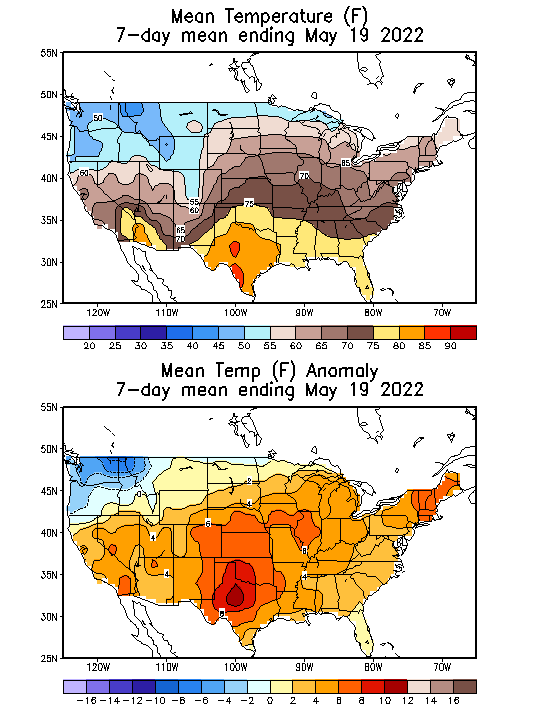
Data source: National Oceanic and Atmospheric Administration
Deviation between average and normal temperature (°F)
7-day mean ending May 19, 2022

Data source: National Oceanic and Atmospheric Administration


